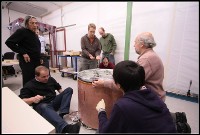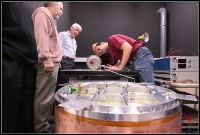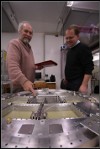 |
 |
|||||||||||||
|
|||||||||||||
|
|||||||||||||
The time projection chamber is part of the tracker system of a future ILD detector at the ILC and will one day reproduce highly precise tracks of the particles that passed through its gas. A plot of all the tracks leading to a workshop called ‘the tent’ on the DESY campus would make for an interesting event display: in the course of the last weeks many parts for the detector prototype arrived from destinations around the world, together with their experts. While field cage, cathode and module dummies came from Germany, the anode endplate travelled all the way from Cornell University in the States. France brought a Micromegas readout module, Belgium contributed the trigger logic and the Netherlands the beam trigger equipment for the coming test with cosmic rays or test beam. The most recent goal: to put all the different parts together, check if they fit the way they are supposed to fit, make the whole cage gastight and put it under pressure while applying a voltage. Technical coordinator Klaus Dehmelt from DESY can tick all those off his list: “We are now about to prepare the field cage and the endplates for the beam test with the Micromegas module starting this week.” A whole number of intermediate steps was needed to get there. First the team had to make sure that the endplate, produced by Dan Peterson's group in Cornell, fitted to the field cage, produced by industry and ordered by DESY's TPC group. It did. The endplate has seven slots for readout modules — this is where the electrons knocked out by passing particles will travel when the detector is running. Seven dummy modules from Bonn in Germany had to pass the fit test. They did. The one active module, supplied by Saclay, had to pass the same test (and did). The team took it out before putting the closed field cage under pressure, but they now know that they can install the active modules for the coming tests. Finally, all connectors and closing parts between barrel and endplate were in place and exposed to a few millibars of pressure as well as an electric field of 16 kilovolts. “We are pleased to officially declare the field cage gastight,” says Takeshi Matsuda, on a sabbatical at DESY from KEK. “It also holds the field in air. We are ready to move on to the next step.” The team from Saclay is expected back at DESY this week for a first test of the active modules in the closed field cage in an electron beam. The TPC prototype will then run the same test in a magnetic field, coming from a one-Tesla superconducting magnet on loan from KEK. -- Barbara Warmbein |
|||||||||||||
| © International Linear Collider |


